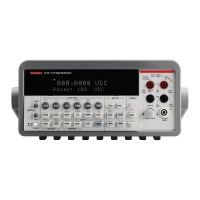B-2 Return to Section Topics 2100-900-01 Rev. D / September 2011
Appendix B: Remote Interface Reference Model 2100 6 1/2-Digit Resolution Digital Multimeter User’s Manual
An introduction to SCPI language
SCPI (Standard Commands for Programmable Instruments) is an ASCII-based instrument
command language designed for test and measurement instruments.
SCPI commands are based on a hierarchical structure, also known as a tree system. In this
system, associated commands are grouped together under a common node or root, thus forming
subsystems. A portion of the SENSe subsystem is shown below to illustrate the tree system.
[SENSe:]
VOLTage:
DC:RANGe {<range>|MINimum|MAXimum}
VOLTage:
DC:RANGe? [MINimum|MAXimum]
FREQuency:
VOLTage:RANGe {<range>|MINimum|MAXimum}
FREQuency:
VOLTage:RANGe? [MINimum|MAXimum]
DETector:
BANDwidth {3|20|200|MINimum|MAXimum}
DETector:
BANDwidth? [MINimum|MAXimum]
ZERO:
AUTO {OFF|ONCE|ON}
ZERO:
AUTO?
SENSe is the root keyword of the command; VOLTage, FREQuency, DETector, and ZERO are
second-level keywords; and DC, VOLTage, BANDwidth, and AUTO are third-level keywords. A
colon ( : ) separates a command keyword from a lower-level keyword.
Command format used in this manual
The format used to show commands in this manual is shown below:

